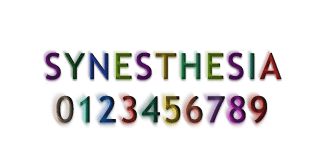Synesthesia: Difference between revisions
No edit summary |
No edit summary |
||
| Line 1: | Line 1: | ||
[[File: | [[File:Synestheticwiki3.png]] | ||
The word “synesthesia” or “synaesthesia,” has its origin in the [https://en.wikipedia.org/wiki/Greek_language Greek] roots, syn, meaning union, and aesthesis, meaning sensation: a union of the senses.<ref name=Foot01/> Synesthesia is usually used in [https://en.wikipedia.org/wiki/Poetry poetry]. In Poetry it means the concurrent response of two or more of the senses to the stimulation of one<ref name=Foot02/> . In simple terms synesthesia means the mixing of two or more senses at one time. Several authors use synethesia; such as [https://en.wikipedia.org/wiki/Robert_Frost Robert Frost], [https://en.wikipedia.org/wiki/Emily_Dickinson Emily Dickinson], [https://en.wikipedia.org/wiki/Vladimir_Nabokov Vladimir Nabokov], [https://en.wikipedia.org/wiki/Dante_Alighieri Dante Alighieri], [https://en.wikipedia.org/wiki/George_Meredith George Meredith], [https://en.wikipedia.org/wiki/William_Shakespeare William Shakespeare], and [https://en.wikipedia.org/wiki/John_Keats John Keats]. | The word “synesthesia” or “synaesthesia,” has its origin in the [https://en.wikipedia.org/wiki/Greek_language Greek] roots, syn, meaning union, and aesthesis, meaning sensation: a union of the senses.<ref name=Foot01/> Synesthesia is usually used in [https://en.wikipedia.org/wiki/Poetry poetry]. In Poetry it means the concurrent response of two or more of the senses to the stimulation of one<ref name=Foot02/> . In simple terms synesthesia means the mixing of two or more senses at one time. Several authors use synethesia; such as [https://en.wikipedia.org/wiki/Robert_Frost Robert Frost], [https://en.wikipedia.org/wiki/Emily_Dickinson Emily Dickinson], [https://en.wikipedia.org/wiki/Vladimir_Nabokov Vladimir Nabokov], [https://en.wikipedia.org/wiki/Dante_Alighieri Dante Alighieri], [https://en.wikipedia.org/wiki/George_Meredith George Meredith], [https://en.wikipedia.org/wiki/William_Shakespeare William Shakespeare], and [https://en.wikipedia.org/wiki/John_Keats John Keats]. | ||
Revision as of 20:38, 17 April 2014
The word “synesthesia” or “synaesthesia,” has its origin in the Greek roots, syn, meaning union, and aesthesis, meaning sensation: a union of the senses.[1] Synesthesia is usually used in poetry. In Poetry it means the concurrent response of two or more of the senses to the stimulation of one[2] . In simple terms synesthesia means the mixing of two or more senses at one time. Several authors use synethesia; such as Robert Frost, Emily Dickinson, Vladimir Nabokov, Dante Alighieri, George Meredith, William Shakespeare, and John Keats.
Functions of Synesthesia
Synesthesia is used to give writing more meaning. It is to make the reader feel more than what is written on the page or screen. The term gives writers the extra boost of creativity and description. Synesthesia makes writing more interesting and appealing to an audience. This literary device can also be used to add confusion and excitement to writing.[3]
Examples of Synesthesia
Literature
- Back to the region where the sun is silent. -'The Divine Comedy' by Dante Alighieri[4]
- Drink the pale drug of silence - 'Modern Love: I' by George Meredith[5]
- The butterfly and I had lit upon, Nevertheless, a message from the dawn, That made me hear the wakening birds around, And hear his long scythe whispering to the ground, 'The Tuft of Flowers' By Robert Frost[6]
Everyday Life
- Loud Shirt
- Cool Sweater
- Frozen Silence
References
- ↑ Allen-Hermanson, Sean. Matey, Jennifer. Synesthesia
- ↑ Harmon, William. Holman, Hugh. “A Handbook to Literature." Ninth Edition. (2002). Prentice Hall.
- ↑ Trent, Ann. What Is Synesthesia in Poetry? classroom.synonym
- ↑ Greggor, Chad. Examples of Synesthesia in Language and Literature. Retrieved 9 April 2014 from suite
- ↑ Meredith, George. "Modern Love: I". Poetry Foundation. Web. 9 April 2014.
- ↑ Frost, Robert. "The Tuft of Flowers" Poetry Foundation. Web. 9 April 2014.
Notes
- Bavota, C. Synesthesia. Literary Devices
- Bureman, Liz. Synesthesia In Literature: Definition and Examples Retrieved 9 April 2014 from The Write Practice

